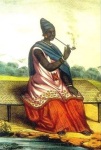
In 1855, when the French arrived to colonize Senegal, the first power of resistance they encountered was a woman. Her name was: Ndate Yalla Mbodj. While in France, women were not recognized as citizens until 90 years later, the French were stunned by this woman of beautiful stature, face, and strong body, and who headed an immense army. She was a beautiful and proud warrior, who inherited a rich tradition of bravery and gallantry.
The Lingeer or Queen Ndate Yalla Mbodj (1810 – 1860) was the last great queen of the Waalo, a kingdom in the northwest of modern-day Senegal. She was a heroine of the resistance against French colonization and Moors invasion. She was also the mother of Sidya Leon Diop or Sidya Ndate Yalla Diop, who went on to become one the greatest resistants to the colonization of Senegal.

Queen Ndate succeeded to her sister Ndjeumbeut Mbodj. She was officially crowned Queen of the Waalo on October 1st 1846 in Ndar (now called Saint-Louis), the capital of the Waalo. Her reign was marked by an ongoing defiance of the French against which she fought a fierce battle. By 1847, she opposed the free passage of Sarakolé people by sending a letter to the governor expressing her willingness to defend the respect of her sovereignty over the valley in these terms: “We guarantee and control the passage of cattle in our country and we will not accept it the other way. Each leader governs his country as he pleases.“

She fought both the Moors who happen to encroach on her territory, and the colonialist army led by Louis Faidherbe, the butcher, and bandit, who later became governor of Saint-Louis and colonial head of administration and army. Almost 10 years into her reign in 1855, she encountered the greatest colonialist pirate Faidherbe, with an army of 15,000 strong, fully armed and ready to fight her, dethrone her, and colonize Waalo and Senegal. Faidherbe defeated her army in bloody battles, before capturing Saint-Louis. In February 1855, while the Faidherbe’s troops were entering the Waalo, the Lingeer spoke to the principal dignitaries of her country as such: “Today, we are invaded by the conquerors. Our army is in disarray. The tiedos of the Waalo, as brave warriors as they are, have almost all fallen under the enemy’s bullets. The invader is stronger than us, I know, but should we abandon the Waalo to foreign hands?” (Aujourd’hui nous sommes envahis par les conquérants. Notre armée est en déroute. Les tiédos du Walo, si vaillants guerriers soient-ils, sont presque tous tombés sous les balles de l’ennemi. L’envahisseur est plus fort que nous, je le sais, mais devrions-nous abandonner le Walo aux mains des étrangers?) … “This country is mine alone!”
She eventually lost the battle, but not the war; which continued to be a war of resistance until the early part of the twentieth century by Lat Dior Diop, and many other ‘Gelewars’. This conquest would forever change the trajectory of her reign and the geopolitical, military, and geographical road map of Senegambia, “Ganaar” (now called Mauritania), Mali (formerly called French Sudan), and Fouta.

Her father was Brak (King) Amar Fatim Borso Mbodj, and mother was Lingeer (Queen) Awo Fatim Yamar Khuri Yaye Mboge. Her son, Sidya Leon Diop, who would later too become an anti colonialist, and fight the French until his capture, and exile to die in Gabon in 1878. Her son Sidya was captured as a hostage in Saint-Louis by General Faidherbe during their bloody war with Ndate, and was baptized ‘Leone’ and sent to Algiers for schooling in 1861. When he returned to Senegal two years later in 1863, he was enlisted in the French colonial army; the first African or Senegalese to hold such a post. But as the saying goes —like mother, like son, he refused to do their dirty job of joining forces with the European colonial foreigners and mercenary apparatus, against his mother’s kingdom and people. He then changed strategy and rallied with Lat Dior Diop and others, which resulted in his betrayal, and capture by the colonial forces; and exile to Gabon (just like Samori Toure).

Queen Ndate Yalla Mbodj, as a true ‘lingeer’, developed the women’s army as one of the most formidable forces to recon with in her reign. The story of this Senegambia Queen is best amplified in oral tradition by the local griots. Her women army was similar to the “Amazon” women army of Benin, Behanzin’s fearless protective women’s army. She later went into exile in Ndimb in the northern part of the Waalo and died in Dagana, where today a statue has been erected in her honor (the only one erected in honor of a queen nationwide). To learn more, check out: Maafanta.com, Matricien.org, au-Senegal.com; the book Kings and Queens of West Africa by Sylviane Diouf has an entire chapter dedicated to this great queen.


What a truly fascinating piece of history, Dr Y. Thank you.
LikeLike
Thanks Tish. It was quite fascinating to learn about her.
LikeLiked by 1 person
Pingback: Fatyly: Contemporary Ceramic Products from Senegal
Thanks for linking to the blog, and for visiting.
LikeLike
Pingback: African Queens Series: Queen Ndate Yalla Mbodj of Senegal - She Led Resistance Against French Colonisation - Uncensored
Reblogged this on Espiritu en Fuego/A Fiery Spirit and commented:
Queen Ndate Yalla Mbodj: Senegalese Queen leading the Resistance against French Colonization
LikeLike
Thanks for reblogging. I truly appreciate it.
LikeLike
Pingback: African Queens Series: Queen Ndate Yalla Mbodj of Senegal – She Led Resistance Against French Colonisation – Uncensored Opinion
Pingback: Ndaté Yalla Mbodj: l'incubo dei coloni | Afroconnesioni-News
Pingback: Meet Ndaté Yalla Mbodj, The Last Queen Of Senegal Who Fought Off The French, Arabs And Moors | How Africa News
Pingback: Ndaté Yalla Mbodj: The African Queen Who Fought Against the French Colonization
Pingback: Be a Feminist: It is the right thing to do. HAPPY INTERNATIONAL WOMEN’S Day 2022! – GIRL NOW WOMAN LATER